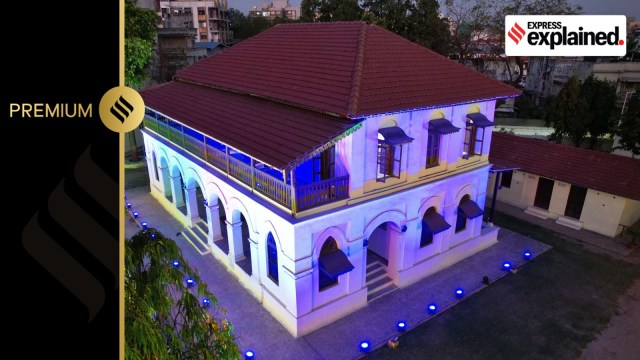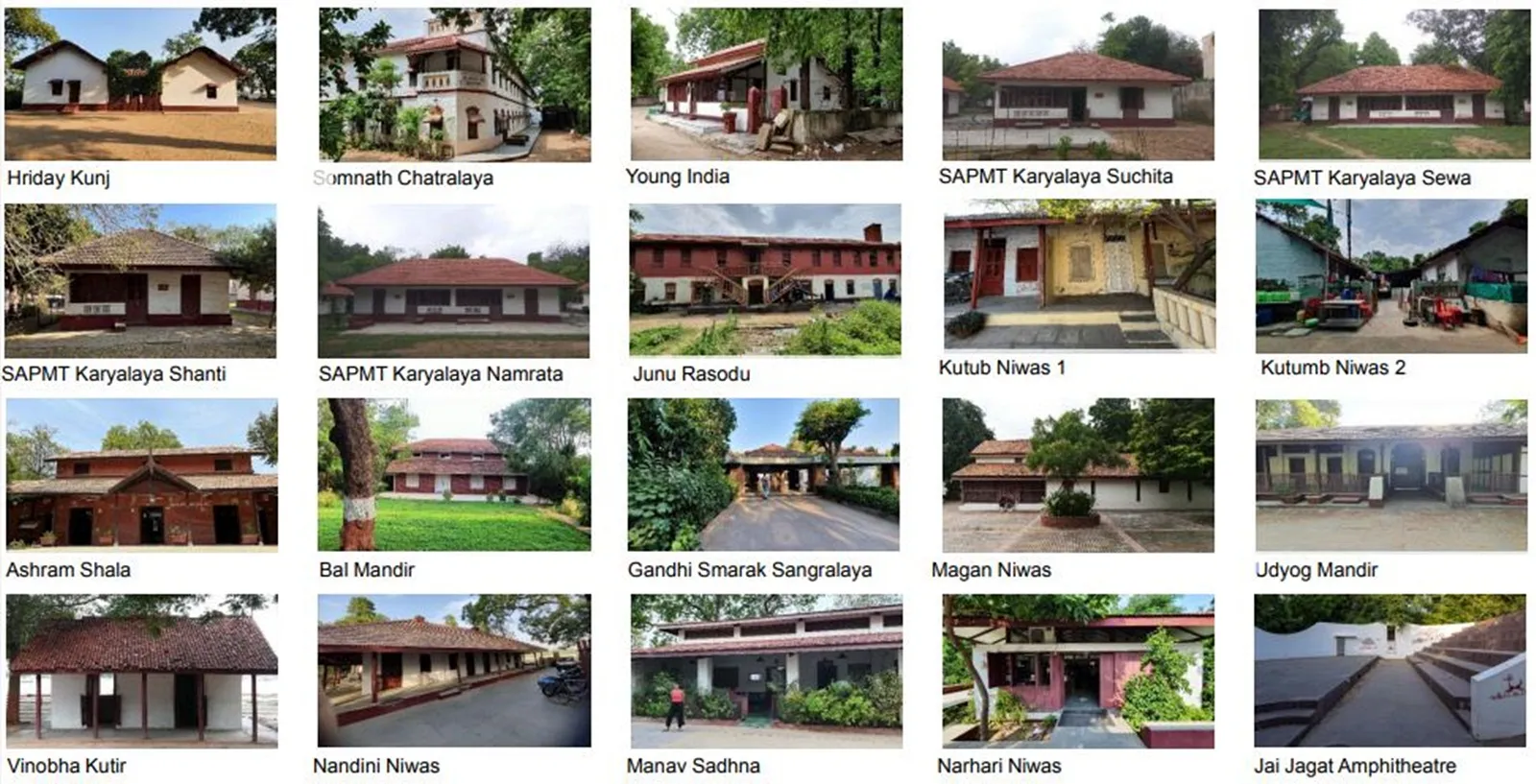Simplicity and modernisation: What the redeveloped Sabarmati Ashram seeks to achieve
Prime Minister Narendra Modi will perform the ‘Ashram Bhoomi Vandana’, a symbolic laying of the foundation stone, and unveil the masterplan of the Rs 1,200 crore Gandhi Ashram Memorial and Precinct Development Project in Ahmedabad. Here’s what will change in the Ashram that Mahatma Gandhi built in 1917.
 The redeveloped 'Kochrab Ashram' inaugurated by Prime Minister Narendra Modi in Ahmedabad.
The redeveloped 'Kochrab Ashram' inaugurated by Prime Minister Narendra Modi in Ahmedabad. On March 12, marking the 94th anniversary of the Dandi March that began from the Sabarmati Ashram, Prime Minister Narendra Modi performed the ‘Ashram Bhoomi Vandana’, a symbolic laying of the foundation stone, and unveiled the masterplan of the Rs 1,200 crore Gandhi Ashram Memorial and Precinct Development Project. The Prime Minister also inaugurated the redeveloped Kocharab ashram from Ahmedabad.
What’s in the proposed masterplan for the Sabarmati Ashram?
Prepared by Ahmedabad-based HCP Design, Planning and Management Pvt Ltd (HCPDPM) led by Bimal Patel, the masterplan proposes to restore, conserve, and rebuild about half of the 63 structures that existed in the original ashram that was spread over 120 acres of land on the banks of the Sabarmati River on the outskirts of Ahmedabad. In all, 36 buildings will be restored.
The place that is popularly known as Sabarmati Ashram currently, and is open to the public, covers only 5 acres of this original space. It is managed by the Sabarmati Ashram Preservation and Memorial Trust (SAPMT).
The new memorial will be spread over 55 acres, and the entire precincts will sprawl over 322 acres. An official said that if an hour is needed for a quick tour of the current Gandhi Ashram, it will take at least 6-7 hours for a visitor to tour the entire expanded premises when the project is completed.
According to the masterplan, 20 buildings will be conserved — this list includes Hriday Kunj, the residence of Mahatma Gandhi and Kasturba; the Gandhi Memorial Museum designed by the late Charles Correa which opened in 1963; Nandini Niwas, which served as the guest house; Manav Sadhna, run by Jayesh Patel, son of its Gandhian founder Ishwarbhai Patel, and the son-in-law of Uttar Pradesh Governor Anandi Patel; Vinoba-Mira Kutir, where Vinoba Bhave stayed; the Jay Jagat Amphitheatre; and the Junu Rasodu (Old Kitchen).
 Buildings to be conserved as part of Sabarmati redevelopment.
Buildings to be conserved as part of Sabarmati redevelopment.
Thirteen buildings — which include two gaushalas, Sardar Vallabhbhai Patel’s office, and Dus Ordi (Ten Rooms) — will be restored.
And three buildings — the Dehla Puni Kendra (place for storing cotton bales), Saat Ordi (Seven Rooms), and Anand Bhawan Sanghralaya — are proposed to be rebuilt.
What is the historical importance of the Gandhi Ashram at Sabarmati?
Gandhi set up five settlements during his lifetime — two in South Africa (Phoenix Settlement in Natal, and Tolstoy Farm outside Johannesburg), where he lived from 1893 to 1914, and three in India, where he arrived in January 1915.
The settlements were “places of continuous experiment and search”, Neelkanth Chhaya, a former professor at CEPT University, wrote in the recently released book, ‘Gandhi’s Places: An Architectural Documentation’, co-authored by Ahmedabad architect Riyaz Tayyibji and Gandhian scholar Tridip Suhrud.
Gandhi set up the first ashram in Ahmedabad in Kocharab in 1915. It was an “already built space, rented for use by the ashram and was therefore not according to Gandhi’s own ideas of how such a place should be designed and built”, Chhaya wrote.
Thus, in 1917, Gandhi founded the ashram at Sabarmati — his fourth ashram — on the western bank of the Sabarmati River. The location was to the north of the village of Juna Vadaj, beyond the Chandrabhaga rivulet, a tributary of the Sabarmati. On the opposite bank of the river from the ashram “stood the skyline of the city, marked by the many chimneys of textile mills”, Chhaya wrote.
The ashram at Sabarmati is seen to be the most important in Gandhi’s life and work. It was a space that Gandhi designed himself, and was built using local material. He spent the most time here, and it was the cradle of eight major movements related to India’s struggle for independence.
Apart from the Dandi March that Gandhi began from here on March 12, 1930, he also launched the Champaran Satyagraha (1917), the Ahmedabad mills strike and Kheda Satyagraha (1918), the Khadi movement (1918), the Rowlatt Act and Khilafat Movements (1919), and the Non-Cooperation movement (1920) while living in Sabarmati.
What will be added to the existing ashram as part of the redevelopment project?
According to the masterplan, the redeveloped memorial and precincts will have an orientation centre, a scholars’ residency, a parking area, a water harvesting pond, souvenir shops, two exhibition areas, a cafeteria, a workshop area, and a grand entrance plaza.
The redevelopment and restoration plan is based on an aerial image from 1949 of the ashram, and a 200-page concept note prepared by the SAPMT based on the ashram’s documented accounts, brochures, and “a study of the visitors’ books of last ten years to understand what people want from this space”, a source closely associated with the project said.
The plan for the orientation centre is based on such feedback, especially from educational institutions that brought students to visit the ashram. The ashram has been maintaining a visitors’ book since 1963 — eminent visitors include Queen Elizabeth (1961), the Dalai Lama (1984-85), former Irish President Mary Robinson (1993), South Africa’s former President Nelson Mandela (1995), and former US President Bill Clinton (2001).
The concept note also has a brief on what each of the buildings in the ashram premises “should be like”. After distilling the opinions of visitors over the last 10 years in the designated book, the SAPMT has proposed that the redeveloped ashram should maintain its simplicity and “ethos”.
How will the existing buildings be used once the redevelopment is done?
The existing buildings will tell the story of the ashram, host exhibitions and galleries on Gandhi’s works in India and abroad, describe his movements and yatras, and have information about his daily routine, important events of his life, and his engagement with children and the youth. There will be information on his key associates and important visitors to the ashram before 1930, when Gandhi and Kasturba lived there.
There will also be a feature on the “principal Ashramites” from 1917 to 1951, and a gallery of women leaders. One of the buildings will house charkhas and khadi production centres. A section on “Gandhiji’s Legacy” will contain manuscripts and honours he got, exchanges with the postal department, journals, and texts.
At least 261 of the 263 residents of the ashram premises, called Ashramwasis, have been evacuated and compensated to make way for the project. The total compensation for relocation has been Rs 375 crore.
And what will be new in the redeveloped Ashram?
To begin with, Ashram Road, one of Ahmedabad’s oldest commercial arteries, will be closed from where the Gandhi Ashram begins in order to consolidate the areas that are now on the two sides of the road into one contiguous space. This is likely to happen in phases beginning March 12, and an alternative road will be opened to commuters.
The new buildings will largely house administrative offices, meeting rooms, a space for interactive workshops for paper-making, leather-making, Gandhian history, lectures and seminars, an “experience centre” and public conveniences.
The new spaces will “enable the visitors to recreate and live a glimpse of Gandhiji’s daily routine”, the Gujarat government has said in a note. “Hands-on workshops on activities such as spinning-wheel, producing hand-made textile and paper, will also be incorporated at the Ashram. These will allow the visitors to immerse themselves in Gandhiji’s principles of sustainability and self-sufficiency,” the note says.
What will the declared efforts to retain the ethos, and the simplicity of the Ashram entail?
When the project was announced in 2021, concerns were raised that it would turn the Ashram into a “Gandhi theme park”. The Gujarat government had assured the Ashram trustees at the time that there would be no “sarkarikaran” (governmentalisation) of the Ashram.
The 200-page concept note that SAPMT prepared in consultation with other Gandhian institutions across the country emphasised that simplicity, one of the values that Gandhi practised and cherished, should be maintained, and that no fees should be charged either from visitors, or from resident research scholars. The note also said that “no red carpet” should be laid out for VVIP visitors to the Ashram, a source in the know said.
“None of the existing structures dating back to that time will be touched,” a source connected with the projects said. The source also said that the development project would use “zero” steel, cement, and concrete, and would instead use local materials such as lime plaster, terracotta roof tiles, and Valsadi teak.
The Gujarat government has said that “utmost care will be taken to retain [the Ashram’s] timeless essence while refashioning it with a new outlook, keeping in mind the sacrosanct goal of abiding by the Ashram’s original architectural simplicity and essence.” The aim is to “furbish the Ashram in a manner that it exudes greenery, serenity and lush tranquility to all the visitors”, it has said.
According to the statement, the rejuvenation project would be taken forward with “utmost sensitivity and respect to the fact that the Ashram’s existence goes beyond the idea of mere physical space”. The sacred Ashram, it says, “stands as a symbol of sacrifice and perseverance of freedom fighters, a haven for introspection, and a crucible of moral values”, where “Gandhiji’s legacy of simplicity and profound ideology resonates through every corner”.
- 01
- 02
- 03
- 04
- 05










































